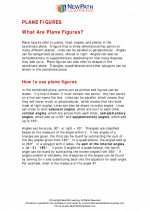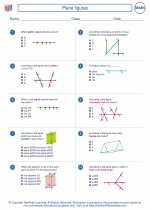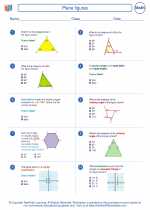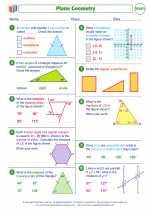Solids in Geometry
In geometry, a solid is a three-dimensional shape that has length, width, and height. There are various types of solids, including prisms, pyramids, cylinders, cones, and spheres. Understanding the properties of these solids is important in geometry and can help in solving problems related to volume, surface area, and other geometric calculations.
Types of Solids
Prisms: Prisms are polyhedra with two parallel and congruent polygonal bases connected by rectangular or parallelogram lateral faces. Examples include rectangular prisms, triangular prisms, and hexagonal prisms.
Pyramids: Pyramids have a polygonal base and triangular lateral faces that meet at a common vertex. The height of a pyramid is the perpendicular distance from the base to the apex (top).
Cylinders: Cylinders have two parallel circular bases connected by a curved surface. The height of a cylinder is the distance between its two bases.
Cones: Cones have a circular base and a curved surface that tapers to a point called the apex. The height of a cone is the distance from the base to the apex.
Spheres: Spheres are perfectly round solids with all points on the surface equidistant from the center. The radius of a sphere is the distance from the center to any point on the surface.
Properties of Solids
Each type of solid has specific properties related to its bases, lateral faces, height, and other dimensions. Understanding these properties is crucial for calculating the volume, surface area, and other characteristics of the solids. For example, the volume of a prism is given by the formula V = Bh, where B is the area of the base and h is the height. Similarly, the volume of a cylinder is given by V = πr2h, where r is the radius of the base and h is the height.
Study Guide
When studying solids in geometry, it's important to focus on the following key concepts:
- Identifying the different types of solids and their distinguishing features.
- Understanding the formulas for calculating the volume and surface area of each type of solid.
- Practicing problems involving the properties of solids, such as finding the height, radius, or base area based on given information.
- Exploring real-world applications of solid geometry, such as calculating the volume of containers, the surface area of objects, and more.
- Using visual aids, such as diagrams and models, to enhance understanding of spatial relationships within solids.
By mastering these concepts and practicing related problems, you can develop a strong foundation in solid geometry and excel in geometric calculations involving three-dimensional shapes.
[Solid] Related Worksheets and Study Guides:
.◂Math Worksheets and Study Guides Eighth Grade. Plane figures

 Worksheet/Answer key
Worksheet/Answer key
 Worksheet/Answer key
Worksheet/Answer key
 Worksheet/Answer key
Worksheet/Answer key
 Worksheet/Answer key
Worksheet/Answer key
